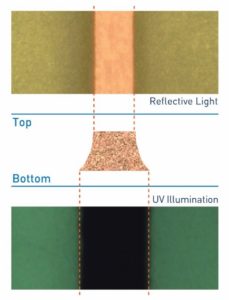5G can be up to 100 times faster than 4G with 100 times higher data capacity and latency of under one millisecond. What does this mean for PCBs?
5G presents new design and manufacturing challenges for high-frequency PCBs, which bring to the table tight pattern designs and complex materials. Thus, the industry needs new imaging, inspection, and metrology technologies to manufacture the PCBs needed for 5G infrastructure and devices.
5G infrastructure, including cellular base stations, data servers, high-performance computing systems, and AI, increases the demand for fine line IC substrates and high layer count (HLC) multi-layer boards (MLB). On the device side, 5G antennas, camera modules, and display drivers increase the demand for flex PCBs, any-layer high-density interconnects (HDI), as well as for higher density PCBs with advanced HDI. All these PCB design requirements for 5G push or exceed the limits of traditional PCB manufacturing technology.
Imaging technology
Several advanced manufacturing technologies are poised to provide the imaging and inspection capabilities needed to ensure higher quality and more complex PCBs for 5G. These include laser direct imaging (DI), automated optical inspection (AOI) and automated optical shaping and repair. The requirements for manufacturing PCBs used in 5G infrastructure and 5G devices are, however, different.
On the 5G infrastructure side, DI technology enables the tight impedance control required for high-frequency 5G such as mmWave, as well as high accuracy on large panels and tight front-to-back accuracy to meet demands on high-layer count MLBs. High-capacity solder mask (SM) DI technology can support large (up to 32 in.) and warped panels, while meeting 5G’s demands for higher resolution and accuracy.
Automated optical inspection
Ideally, automated optical inspection (AOI) should offer detection and measurement with minimum handling, while providing the capability to inspect the fine lines of IC substrates down to 5 µm, which are typical for HPC and data servers found in the 5G infrastructure.
For 5G devices, DI can provide high-quality imaging with the fine lines, precise conductor geometries, high accuracy, and advanced scaling required for modified semi-additive processes (mSAP) or substrate-like PCBs (SLP) production processes, while maintaining the highest effective throughput and yield.
As the demand grows for smaller form factors, lighter weights and higher functionality in 5G electronics, flex printed circuits (FPCs) become increasingly critical components that present new challenges in manufacturing. Roll-to-roll DI systems enable FPC manufacturers to use roll-based flex materials, while preserving their integrity and minimizing the damage and distortion that frequently occurs.
AOI for PCBs used in devices can be integrated with 2D laser via measurement for all dimensions of the via, including top and bottom diameters, roundness and taper, and location. In addition, AOI with automatic 2D metrology (Figure 1.) is key to ensuring accurate top and bottom measurements for impedance control, important for 5G mmWave antenna boards, for example.
In general, 5G PCB inspection needs must address challenges such as the low contrast layers of materials, transparent flex printed circuits, laser via inspection, fast and accurate metrology for impedance control, along with low cost of ownership. Some inspection processes may also create high contrast imaging of low contrast materials for complete detection without false alarms.
There is another innovative process that should be considered: automated optical shaping and repair. This type of optical repair allows manufacturers to shape – at high speed and high quality – opens and shorts in advanced HDI (mSAP) PCBs and IC substrates as they are identified in the production line. This technology greatly reduces scrapped boards and panels, saves time and labor by eliminating manual repairs, and improves their overall quality and production yield. Advanced automated optical repair may provide manufacturers a competitive advantage of higher yield and quality in mass production for 5G PCBs.
Design and manufacturing challenges
5G’s impact on PCB and IC substrate designs and the processes can enable more precise mass production. For example:
28 GHz Wide-band Base Stations
As the world shifts toward 5G, mini 5G base stations, positioned every 100 m in urban areas, mount on buildings, walls, roofs, traffic lights and more, in contrast to 4G LTE with its large antenna towers situated kilometers apart. These 28 GHz wide-band base stations require PCBs made with new materials, such as fast laminate with low dielectric constant (Dk, contrast) for faster wave speed and up to 30% lower transmission loss. mmWave 5G requires impedance control of down to ±5%, requiring highly accurate PCB line dimensions and the need for in-PCB line metrology on all panels.
In this case, the manufacturing line should include advanced DI for patterning and solder mask, AOI integrated with 2D metrology for complex, high layer count boards.
5G Server Designs
To enable 5G communication, a combination of local and centralized servers is required. This includes hyperscale data servers that will create, process, store and transmit massive volumes of data with the lowest latency possible. The accompanying edge computing functions on real-time data created by sensors or users at the edge of the network (device level), as opposed to in the cloud. Operating these servers and processes requires PCBs with high layer counts, typically from 12 to 22, and as many as 30 for high-performance data servers. The transmission lines require tight impedance control to handle 5G’s high frequency.
To enable high processing computing (HPC) units requires new design of IC substrates that support larger chips up to 110mm × 110 mm and finer line/space down to 5/5 µm.
For superior defect detection, 5G servers demand manufacturing processes with high depth of focus (DoF) for both DI and AOI (Figure 2). AOI with integrated 2D metrology inspection will also be critical for tight impedance control. Boards for 5G servers also require DI for high front-to-back accuracy with tight impedance control, as well as DI for solder mask for large panels. AOI will ensure the requirements are met for fully automated and high throughput MLBs and lastly, an automated optical shaping and repair system is beneficial for low-penetration shaping for shorts and opens on the PCBs.
Figure 2. High depth-of-focus (DoF) ensures superior line quality and uniformity on varying surface topographies.
5G Smartphones
The latest and next generations of 5G smartphones depend upon mSAP/SLP to efficiently transfer signals and power to connected components using very thin interconnectors, all while reducing power consumption. Flexible and rigid flex PCBs are another requirement to facilitate smaller, lighter, and more functional devices. Increasingly complex multiple-input multiple-output (MIMO) antenna configurations are used in 5G smartphones using antenna-in-package (AiP) for high-powered functionality.
Laser via inspection in an AOI system, required for both mSAP/SLP and flex PCBs, ensures the required quality and accurate positioning of the interconnectors. An advanced DI system ensures accurate fine line patterning for mSAP/SLP boards and high depth of focus (DoF) for flex and rigid-flex boards, as well as providing high throughput for increased volume. Lastly, automated optical shaping and repair can greatly reduce the number of scrapped boards by shaping the various defects identified in the inspection process.
Conclusion
Advanced manufacturing technologies let designers create 5G infrastructure and devices as needed to support the new communications protocols and demands. Low latency, high frequency, and complex and fragile materials are no longer a concern for designers if the right manufacturing systems, like laser direct imaging, automated optical inspection and automated optical shaping and repair are employed. And not only do these technologies enable the design and manufacture of 5G components, they can also improve yield in the mass production environment so critical to the deployment and use of 5G.
 Meny Gantz is the Vice President of Marketing & New Product Introduction for Orbotech’s printed circuit board (PCB) division, where he is responsible for guiding the division’s overall marketing and go-to-market product strategies and product roadmaps. Meny joined Orbotech in 2000 and has served in a number of product management and marketing positions within the PCB division, both at the company’s HQ in Israel and in Asia Pacific. Meny is a graduate of MIT’s Artificial Intelligence: Implications for Business Strategy executive program and has an executive MBA from Tel Aviv University. Orbotech is a KLA company.
Meny Gantz is the Vice President of Marketing & New Product Introduction for Orbotech’s printed circuit board (PCB) division, where he is responsible for guiding the division’s overall marketing and go-to-market product strategies and product roadmaps. Meny joined Orbotech in 2000 and has served in a number of product management and marketing positions within the PCB division, both at the company’s HQ in Israel and in Asia Pacific. Meny is a graduate of MIT’s Artificial Intelligence: Implications for Business Strategy executive program and has an executive MBA from Tel Aviv University. Orbotech is a KLA company.









